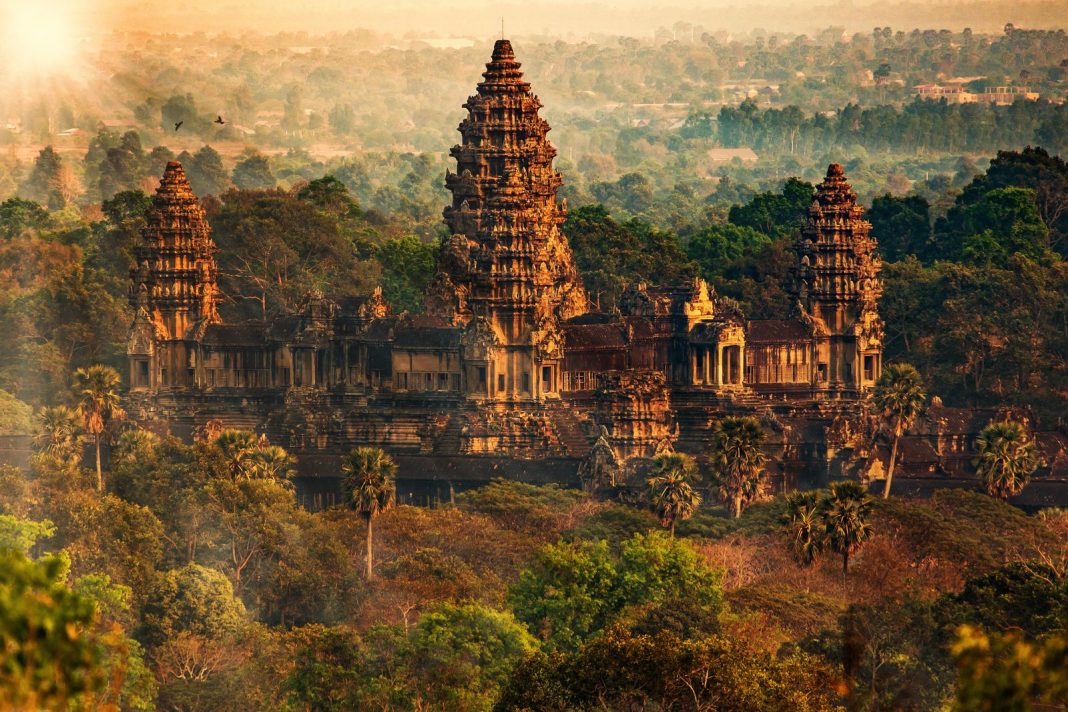Angkor Wat is located about six kilometers (four miles) north of Siem Reap, south of Angkor Thom. Entry and exit to Angkor Wat can only be access from its west gate. Angkor Wat was built in the first half of the 12th century (113-5BC). Estimated construction time of the temple is 30 years by King Suryavarman II, dedicated to Vishnu (Hindu), replica of Angkor Thom style of art.
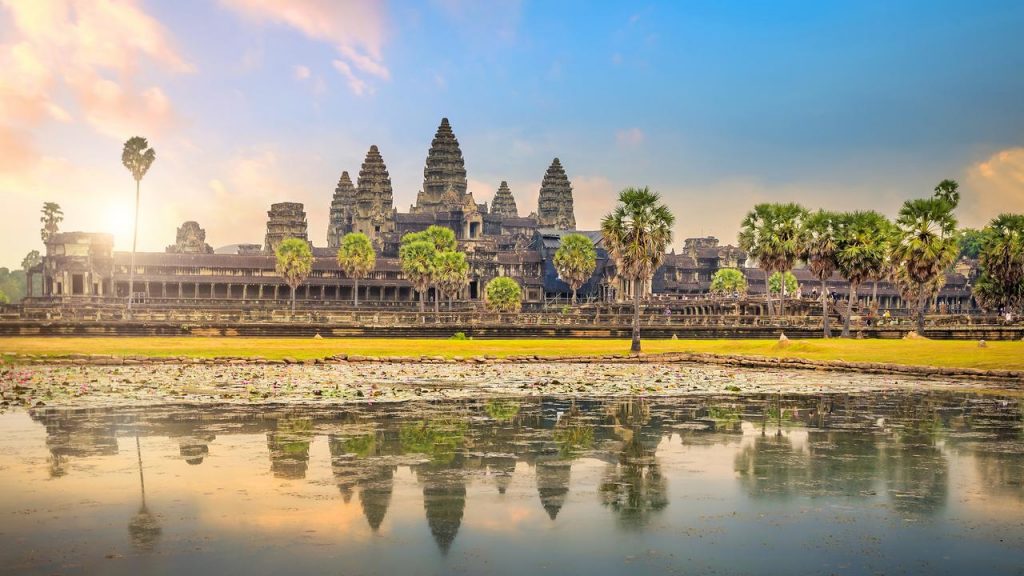
BACKGROUND
Angkor Wat, the largest monument of the Angkor group and the best preserved, is an architectural masterpiece. Its perfection in composition, balance, proportions, relief’s and sculpture make it one of the finest monuments in the world.
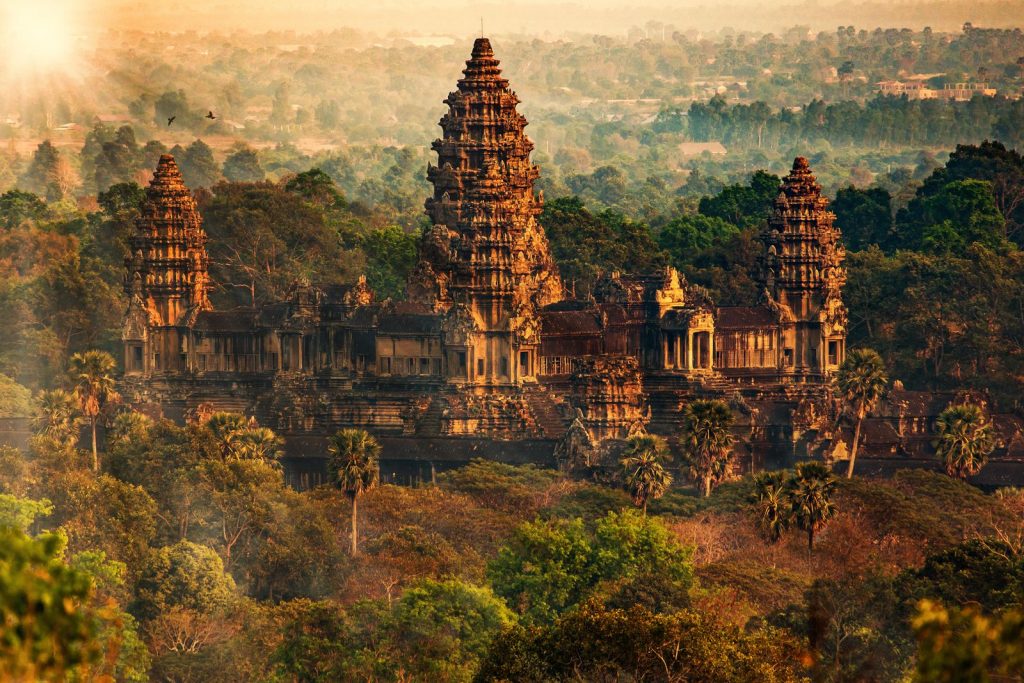
Wat is the Khmer name for temple (the French spelling is “vat “), which was probably added to “Angkor “when it became a Theravada Buddhist monument, most likely in the sixteenth century. After 1432 when the capital moved to Phnom Penh, Angkor Wat was cared for by Buddhist monks.
It is generally accepted that Angkor Wat was a funerary temple for King Suryavarman II and oriented to the west to conform to the symbolism between the setting sun and death. The bas-reliefs, designed for viewing from left to right in the order of Hindu funereal ritual, support this function.
ARCHITECTURAL PLAN
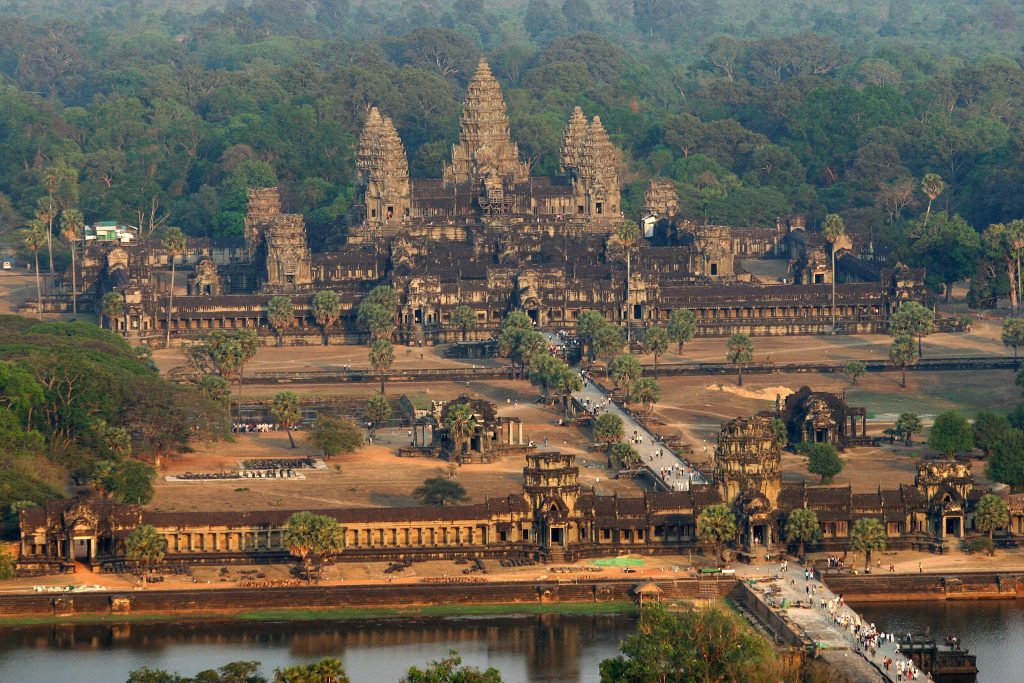
The plan of Angkor Wat is difficult to grasp when walking through the monument because of the vastness. Its complexity and beauty both attract and distract one’s attention. From a distance Angkor Wat appears to be a colossal mass of stone on one level with a long causeway leading to the center but close up it is a series of elevated towers, covered galleries, chambers, porches and courtyards on different levels linked by stairways.
The height of Angkor Wat from the ground to the top of the central tower is greater than it might appear: 213 meters (699 feet), achieved with three rectangular or square levels (1-3) Each one is progressively smaller and higher than the one below starting from the outer limits of the temple.
Covered galleries with columns define the boundaries of the first and second levels. The third level supports five towers –four in the corners and one in the middle and these is the most prominent architectural feature of Angkor Wat. This arrangement is sometimes called a quincunx. Graduated tiers, one rising above the other, give the towers a conical shape and, near the top, rows of lotuses taper to a point.
Apsara
Apsara Statue at Angkor Wat
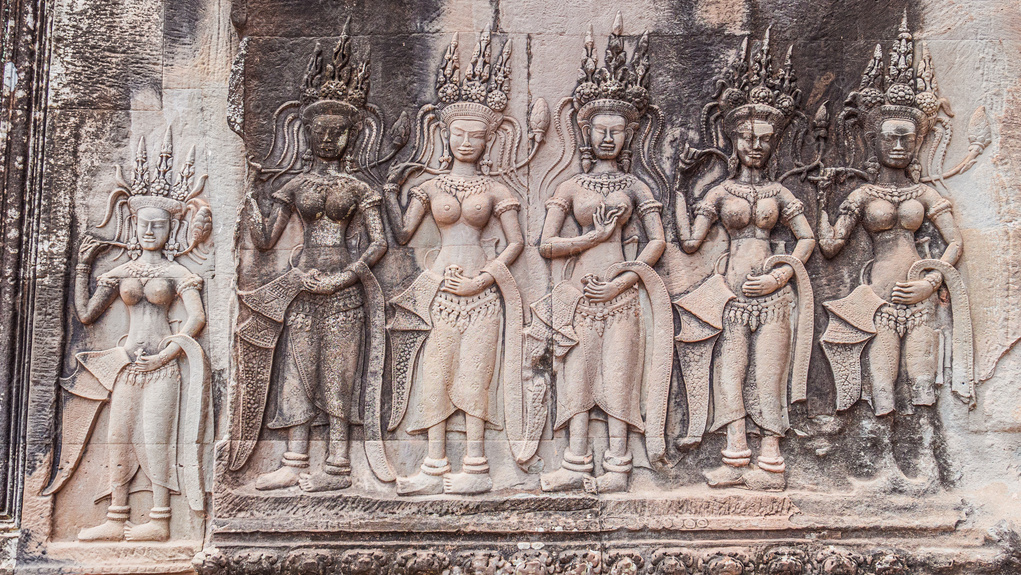
The overall profile imitates a lotus bud, Several architectural lines stand out in the profile of the monument. The eye is drawn left and right to the horizontal aspect of the levels and upward to the soaring height of the towers. The ingenious plan of Angkor Wat only allows a view of all five towers from certain angles. They are not visible, for example, from the entrance. Many of the structures and courtyards are in the shape of a cross. The. Visitor should study the plan on page 86 and become familiar with this dominant layout. A curved sloping roof on galleries, chambers and aisles is a hallmark of Angkor Wat. From a distance it looks like a series of long narrow ridges but close up from identifies itself. It is a roof made of gracefully arched stone rectangles placed end to end. Each row of tiles is capped with an end tile at right angles the ridge of the roof.
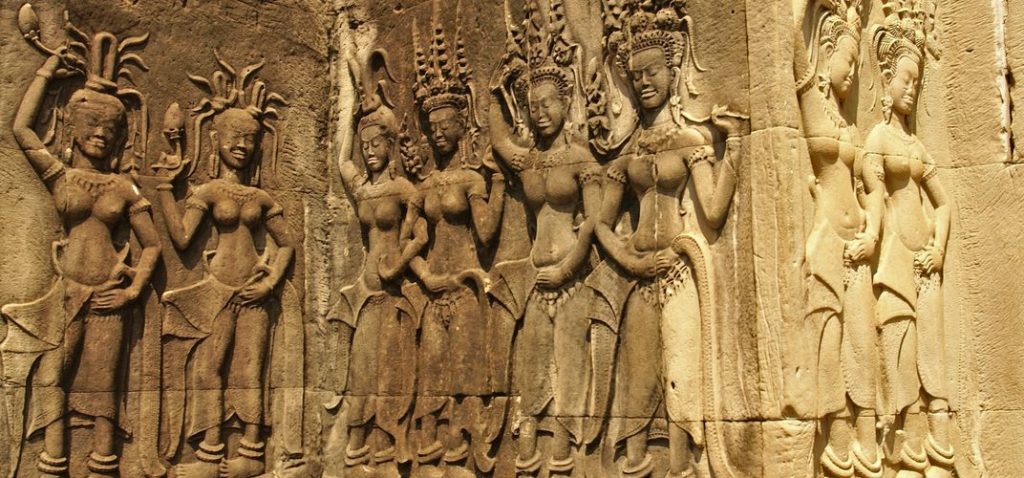
The scheme culminates in decorated tympanums with elaborate frames. Steps provide access to the various levels. Helen Churchill Candee, who visited Angkor in the 1920s, thought their usefulness surpassed their architectural purpose.
The steps to Angkor Wat are made to force a halt at beauteous obstruction that the mind may be prepared for the atmosphere of sanctity, she wrote In order to become familiar with the composition of Angkor Wat the visitor should learn to recognize the repetitive elements in the architecture. Galleries with columns, towers, curved roofs, tympanums, steps and the cross-shaped plan occur again and again.
It was by combining two or more of these aspects that a sense of height was achieved. This arrangement was used to link one part of the monument to another. Roofs were frequently layered to add height, length or dimension. A smaller replica of the central towers was repeated at the limits of two prominent areas-the galleries and the entry pavilions. The long causeway at the entrance reappears on the other side of the entry pavilion.
SYMBOLISM
Angkor Wat is a miniature replica of the universe in stone and represents an earthly model of the cosmic world. The central tower rises from the center of the monument symbolizing the mythical mountain, Meru, situated at the center of the universe. Its five towers correspond to the peaks of Meru. The outer wall corresponds to the mountains at the edge of the world, and the surrounding moat the oceans beyond.
LAYOUT
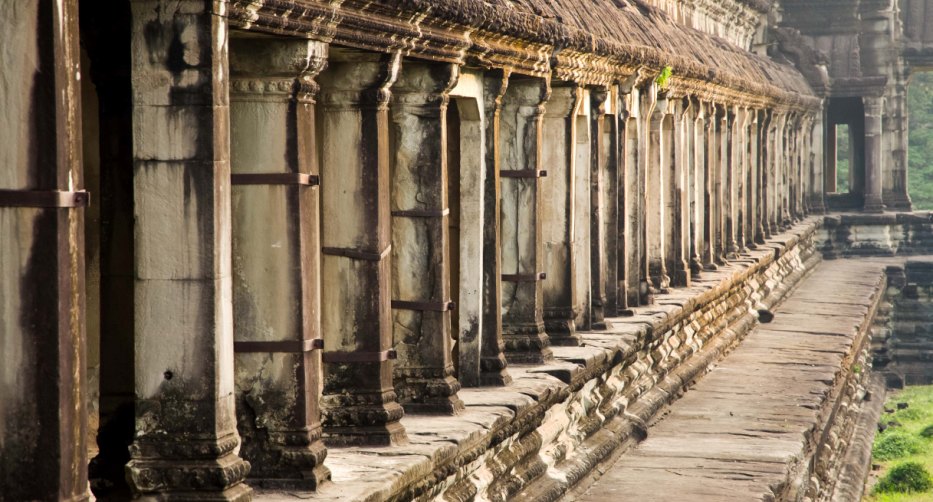
Even though Angkor Wat is the most photographed Khmer monument, nothing approaches the actual experience of seeing this temple. Frank Vincent grasped this sensation over 100 years ago.
The general appearance of the wonder of the temple is beautiful and romantic as well as impressive and grand it must be seen to be understood and appreciated. One can never look upon the ensemble of the vat without a thrill, a pause, a feeling of being caught up onto the heavens. Perhaps it is the most impressive sight in the world of edifices.
Angkor Wat occupies a rectangular area of about 208 hectares (500 acres) defined by a laetrile wall. The first evidence of the site is a moat with a long sandstone causeway (length 250 meters, 820 feet; width 12 meters, 39 feet) crossing it and serving as the main access to the monument. The moat is 200 meters (656 feel) wide with a perimeter of 5.5 kilometers (3.4 miles).
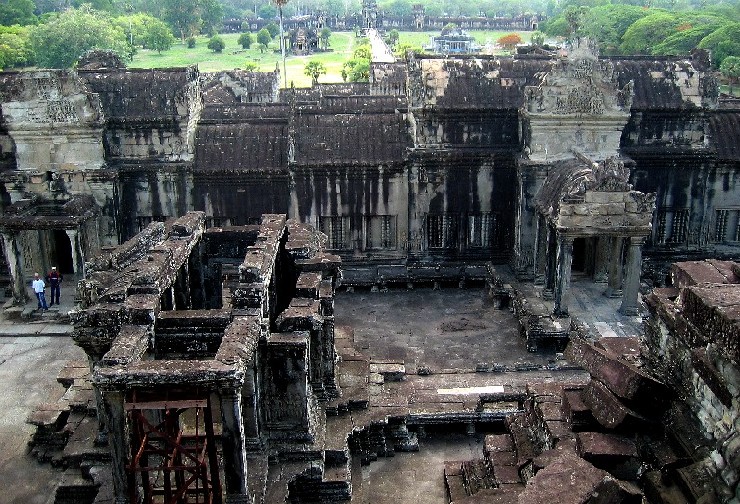
The west entrance begins with steps leading to a raised sandstone terrace in the shape of a cross at the foot of the long causeway. Giant stone lions on each side of the terrace guard the monument. Looking straight ahead, one can see at the end of the causeway the entry gate with three towers of varying heights and with collapsed upper portion. This entry tower hides the full view of the five towers of the central group. A long covered failure with square columns and a curved roof extends along the moat to the left and right of the entry tower. This is the majestic facade of Angkor Wat and a fine example of classical Khmer architecture.
Helen Churchill candee must have been standing on this terrace almost 70 years ago when she wrote Any architect would thrill at the harmony of the fasade, an unbroken stretch of repeated pillars leading from the far angles of the structure to the central opening, which is dominated, by three imposing towers with broken summits. This facade originally had another row of pillars with a roof. Evidence of this remains in a series of round holes set in square based in front of the standing pillars.
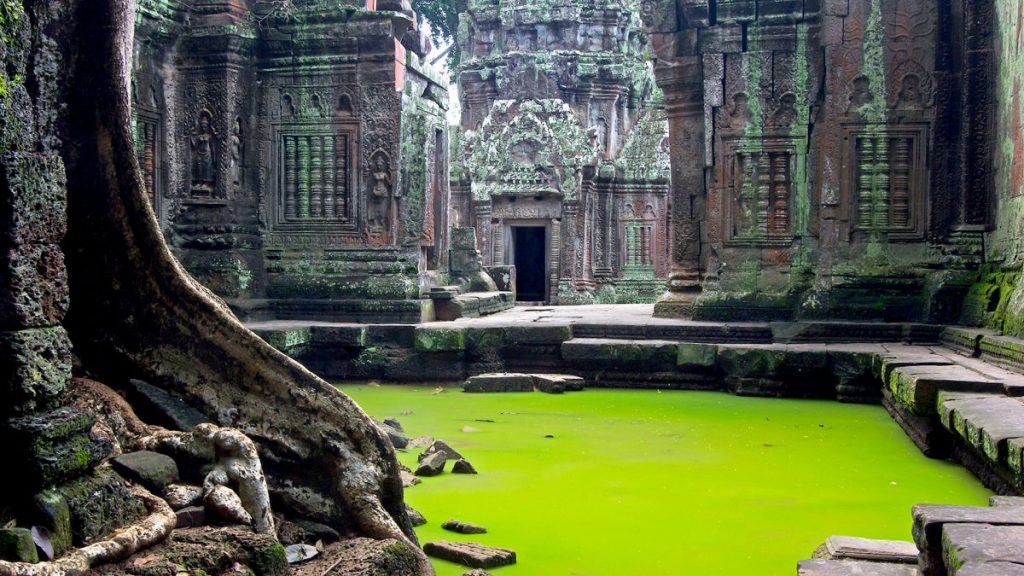
Tip Before proceeding along the causeway turns right, go down the steps of the terrace and walk along the path a few meters for a view of all five towers of Angkor Wat. Return to the center of the terrace and walk down the causeway towards the main part of the temple. The left-hand side of the causeway has more original sand stone than the right-hand side, which was restored by the French.
The upper portions of the three sections on this tower-one each at the center and the two ends – have collapsed. The porches on each end of the gallery may have served as passages for elephants, horses and carts as they are on ground level.
A low balustrade resembling the body of a serpent borders each side. Short columns support the balustrade. Looking west one sees the celebrate view of Angkor Wat that appears on the Cambodian flag. Standing at this point one teels compelled to get to the wondrous group of the five domes, companions of the sky, sisters of the clouds, and determine whether or not one lives in a world of reality or in a fantastic dream. Six pairs of ceremonial stairs with platforms on each side of the walkway lead to the courtyard.
A continuation of the serpent balustrade along the walkway frames the stairs. This arrangement is sometimes called a landing platform. The balustrade terminates with the body of the serpent making a turn at right angles towards the sky and gracefully spreading its nine heads to from the shape of a fan. Two buildings, so-called libraries stand in the courtyard on the left and right, just past the middle of the causeway. These ‘jewel-boxes Khmer art ‘are perfectly formed.
A large central area, four porches, columns and steps present a symmetrical plan in the shape of a cross. Some of the columns have been replaced with cement copies for support. An original pillar lies on the ground before the library on the left. In front of the libraries are two basins (length 65 meters, 213 feet).





